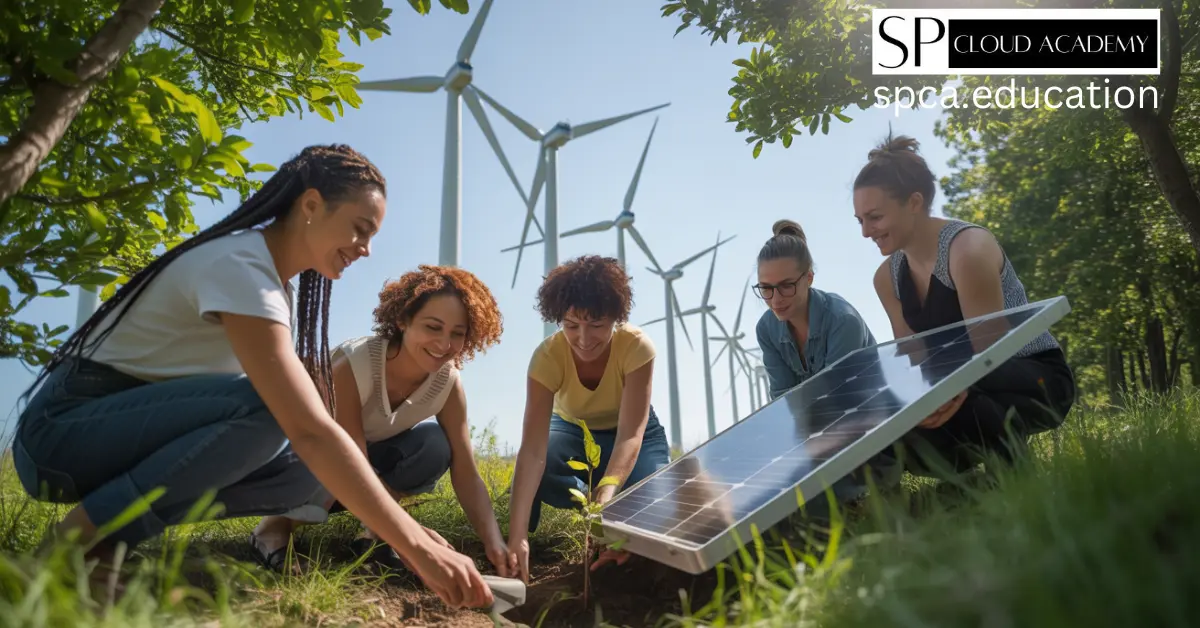Introduction: The Intersection of Gender and Environmental Sustainability
Climate change threatens every corner of our planet, yet the conversation around sustainable development often overlooks a critical catalyst for environmental progress: gender equality. Women comprise nearly half the global population, but their potential to drive green initiatives remains significantly untapped. Research increasingly shows that societies with greater gender parity demonstrate stronger environmental policies, lower carbon emissions, and more effective climate adaptation strategies.
The connection between gender equality and environmental sustainability isn’t coincidental—it’s fundamental. Women in developing nations are often the primary managers of natural resources, yet they’re systematically excluded from decision-making processes that affect their communities. When women gain equal access to education, land rights, and political representation, they become powerful agents of environmental change. They bring unique perspectives shaped by their direct experiences with resource scarcity and climate impacts.
Understanding this hidden link requires examining how gender inequality perpetuates environmental degradation and how empowering women can accelerate our transition to a sustainable future. From renewable energy adoption to conservation efforts, gender-inclusive approaches consistently yield better environmental outcomes. As we face the urgent challenge of limiting global warming and protecting biodiversity, we cannot afford to sideline half of humanity’s innovative potential. The path to a greener future runs directly through gender equality.
Why Women Are Disproportionately Affected by Climate Change
Climate change doesn’t impact everyone equally, and women in developing countries bear the heaviest burden. Approximately 80% of people displaced by climate-related disasters are women, according to United Nations data. This vulnerability stems from deep-rooted social inequalities that limit women’s access to resources, information, and mobility during environmental crises.
In agricultural communities, women produce 60-80% of food in developing nations but own less than 20% of the land. When droughts, floods, or extreme weather events strike, they lack the legal rights and financial resources to recover. Without property ownership or credit access, women farmers cannot invest in climate-resilient crops or irrigation systems that might protect their livelihoods.
Cultural restrictions compound these challenges. In many societies, women have limited freedom of movement and may not be taught survival skills like swimming. During natural disasters, these factors become deadly. The 2004 Indian Ocean tsunami killed three times more women than men in several affected regions, largely due to such social constraints.
Water scarcity particularly affects women, who typically spend hours daily collecting water for their families. As climate change intensifies droughts, women walk longer distances and have less time for education, income generation, or community participation. This creates a cycle where climate impacts reinforce gender inequality, which in turn reduces communities’ capacity to adapt to environmental changes. Breaking this cycle requires recognizing that climate action and gender equality are inseparable goals.
Women as Environmental Leaders and Changemakers
Despite facing systemic barriers, women worldwide are emerging as formidable environmental leaders. From grassroots movements to international policy forums, women consistently champion conservation, renewable energy, and sustainable practices. Nobel laureate Wangari Maathai’s Green Belt Movement planted over 51 million trees across Kenya while empowering thousands of women economically. Her work demonstrates how environmental restoration and women’s empowerment naturally reinforce each other.
Research reveals that countries with higher female parliamentary representation pass more stringent climate policies. A study analyzing 91 countries found that each 1% increase in female parliamentary representation correlates with improved environmental treaty ratification. Women legislators prioritize clean air, water protection, and renewable energy investments at higher rates than their male counterparts, bringing collaborative approaches to environmental governance.
In local communities, women-led conservation projects achieve remarkable success. Female forest management committees in Nepal reduced illegal timber harvesting by 68% compared to male-dominated groups. Women demonstrate stronger commitment to preserving resources for future generations, often taking longer-term perspectives in environmental decision-making.
Indigenous women particularly serve as crucial guardians of traditional ecological knowledge. They maintain understanding of sustainable farming techniques, medicinal plants, and ecosystem management practices refined over generations. When given leadership roles, they effectively bridge ancient wisdom with modern conservation science, creating innovative solutions that respect both cultural heritage and environmental imperatives.
Education: The Foundation for Environmental Action
Educating girls represents one of the most powerful climate solutions available. Project Drawdown ranks educating girls as the sixth most impactful action for reducing global emissions. The mechanism is straightforward: educated women have fewer children, increasing per-capita resources and reducing environmental pressure. They also make more informed decisions about resource consumption, sustainable practices, and climate adaptation.
Each additional year of female education correlates with reduced deforestation rates in their communities. Educated women better understand environmental information, adopt innovative agricultural techniques, and participate more effectively in conservation programs. They’re more likely to support renewable energy adoption and implement household practices that reduce carbon footprints.
Secondary education particularly transforms environmental outcomes. Women who complete secondary school have higher earning potential, delaying marriage and childbearing while improving family welfare. Their children receive better nutrition and education, creating intergenerational benefits that extend to environmental stewardship. These families consume resources more efficiently and contribute more productively to local economies.
However, 129 million girls worldwide remain out of school, primarily in regions most vulnerable to climate change. Poverty, cultural norms, and inadequate infrastructure prevent girls from accessing education. Investing in girls’ education delivers multiple returns: it reduces population growth, strengthens climate resilience, improves public health, and boosts economic development. Every dollar spent on female education yields returns many times over in environmental and social benefits, making it an essential component of any serious climate strategy.
Land Rights and Resource Management
Secure land rights for women unlock tremendous environmental benefits. When women own or control land, they invest more in sustainable agriculture, soil conservation, and long-term productivity. Studies across multiple continents show that female landowners adopt agroforestry, crop rotation, and organic farming practices at higher rates than male landowners.
Currently, women hold less than 15% of agricultural land globally despite performing the majority of agricultural labor. This disparity weakens food security and environmental sustainability. Without ownership rights, women cannot access credit for climate-smart technologies or make permanent improvements to land. They lack incentives to invest in soil health or water conservation when they could lose access at any time.
Countries that have strengthened women’s land rights report measurable environmental improvements. In Ethiopia, land certification programs that included women’s names increased tree planting by 30%. Women with secure tenure plant more trees, protect water sources, and manage forests more sustainably because they expect to benefit from long-term investments.
Community forestry programs demonstrate this principle powerfully. When women participate equally in forest management decisions, deforestation rates decline significantly. Women prioritize sustainable harvesting, biodiversity protection, and equitable resource distribution. They balance immediate household needs with ecosystem preservation more effectively than governance structures that exclude them.
Legal reforms ensuring women’s equal inheritance rights, joint land titling, and protection against dispossession represent critical environmental policies. These changes empower women to become environmental stewards while strengthening community resilience against climate shocks.
Renewable Energy and Green Technology Access
The renewable energy transition cannot succeed without addressing gender disparities. Women comprise only 32% of the renewable energy workforce globally, representing massive untapped talent for the green economy. Expanding women’s participation in clean energy sectors drives innovation while creating inclusive economic growth.
Women face unique energy poverty challenges. In developing regions, 2.4 billion people rely on traditional biomass for cooking, with women bearing primary responsibility for fuel collection. This exposes them to indoor air pollution—killing 3.2 million people annually—while consuming hours that could be spent on education or income generation. Clean cooking solutions directly improve women’s health, safety, and economic opportunities.
Solar energy programs specifically targeting women achieve exceptional success. In India, the Barefoot College trains rural women as solar engineers, bringing electricity to remote villages while creating leadership opportunities. These women-led initiatives achieve higher maintenance rates and better community engagement than conventional approaches. Female solar engineers reinvest their earnings in family welfare and community development at higher rates than male counterparts.
Access to clean energy transforms women’s lives beyond basic electrification. Solar-powered irrigation reduces agricultural labor, enabling women farmers to increase productivity without physical strain. Electric transportation options improve women’s mobility and safety. Renewable energy enterprises offer entrepreneurship opportunities in traditionally male-dominated sectors.
Financing remains a barrier—women entrepreneurs receive less than 7% of venture capital in the energy sector. Targeted funding programs, technical training, and mentorship networks can unlock women’s potential as renewable energy innovators and adopters.
Family Planning and Population Sustainability
Population dynamics significantly influence environmental sustainability, making reproductive healthcare and family planning essential climate strategies. When women control their reproductive choices, birthrates stabilize, reducing resource consumption and environmental pressure while improving quality of life. Project Drawdown identifies family planning as the seventh most important solution for reducing emissions by 2050.
Access to contraception empowers women to space births, complete education, and pursue economic opportunities. Smaller families consume fewer resources per capita and invest more in each child’s education and health. This creates upward mobility while reducing environmental footprints. Countries that expanded family planning access experienced slower population growth alongside economic development and improved environmental indicators.
Currently, 218 million women in developing countries who want to avoid pregnancy lack access to modern contraception. Meeting this unmet need would prevent millions of unintended pregnancies, reduce maternal mortality, and slow population growth in regions with the least capacity for environmental adaptation. It would also prevent substantial carbon emissions—roughly equivalent to eliminating all emissions from France.
Cultural and religious sensitivities complicate family planning discussions, yet most faith traditions support spacing births for maternal and child health. Community-based approaches that involve men and religious leaders achieve better acceptance than top-down programs. Framing family planning as empowering personal choice rather than population control respects human rights while achieving environmental benefits.
Integrating reproductive healthcare with climate adaptation programs creates synergies. Healthy, smaller families better withstand environmental shocks and invest in sustainable practices.
Breaking Barriers: Women in Environmental Decision-Making
Women’s underrepresentation in environmental governance undermines climate action effectiveness. Only 12% of environment ministers globally are women, and women comprise just 20% of national climate negotiation teams. This exclusion results in policies that overlook gender-differentiated climate impacts and miss opportunities for inclusive solutions.
Research consistently shows that diverse decision-making bodies produce better environmental outcomes. Women negotiators prioritize collaborative approaches, long-term sustainability, and social equity. They’re more likely to support binding emissions targets, protect vulnerable populations, and allocate climate finance fairly. Gender-balanced environmental committees in local governments invest more in clean water, public transportation, and green spaces.
Corporate environmental governance also benefits from gender diversity. Companies with women on sustainability boards demonstrate stronger environmental performance, greater transparency, and more ambitious climate targets. Female executives prioritize stakeholder engagement and consider broader social impacts alongside profit motives.
Structural barriers prevent women’s advancement in environmental leadership. Unpaid care responsibilities limit women’s time for political participation. Workplace cultures in environmental sectors often exclude or marginalize women. Harassment and safety concerns discourage women from fieldwork in conservation and research.
Quotas and targeted recruitment programs accelerate progress. Rwanda’s constitutional requirement for 30% female parliamentary representation resulted in women holding 61% of parliamentary seats—the world’s highest—and correlates with strong environmental protections. Mentorship programs, leadership training, and institutional culture changes are equally important for sustaining women’s environmental leadership.
Sustainable Agriculture and Women’s Traditional Knowledge
Women possess invaluable agricultural knowledge that offers solutions to industrial farming’s environmental problems. Traditional farming practices maintained by women emphasize biodiversity, soil health, and ecosystem balance. These time-tested methods provide blueprints for sustainable agriculture that reduces chemical inputs while maintaining productivity.
Women farmers typically cultivate greater crop diversity than men, planting multiple varieties that improve nutrition, reduce pest vulnerability, and enhance climate resilience. In seed saving networks, women preserve heirloom varieties and local crop genetics essential for adaptation. They maintain knowledge of companion planting, natural pest management, and soil enrichment techniques that modern agricultural science is rediscovering.
Agroecology—farming that works with natural ecosystems—aligns closely with women’s traditional practices. Women farmers often integrate livestock, crops, and trees in patterns that maximize land productivity while building soil carbon. They understand seasonal variations, water conservation, and resource cycling that minimize environmental impact.
Yet agricultural extension services overwhelmingly target men, assuming they’re primary farmers despite women’s actual agricultural labor. Women receive only 5% of agricultural extension services globally and have limited access to training, improved seeds, or appropriate technology. This neglect squanders proven sustainable practices and perpetuates inefficient farming methods.
Supporting women farmers with land tenure, credit access, and technical resources could reduce hunger for 150 million people while cutting agricultural emissions. Policies should recognize women’s agricultural expertise, incorporate their knowledge into extension programs, and ensure their equal participation in agricultural development. Scaling up agroecological practices championed by women offers a pathway to feeding growing populations sustainably.
Economic Empowerment and Green Entrepreneurship
Women’s economic participation directly influences environmental sustainability. When women control income, they invest 90% in their families’ health, nutrition, and education compared to 35% for men. This spending pattern supports sustainable consumption, community wellbeing, and long-term development. Economically empowered women become environmental entrepreneurs, creating green businesses that address local challenges.
The green economy offers unprecedented opportunities for women entrepreneurs. From eco-tourism to organic farming, renewable energy installation to sustainable fashion, women are launching businesses that profit while protecting the planet. Female-led green enterprises demonstrate higher survival rates and stronger community impact than conventional startups.
Microfinance programs targeting women achieve remarkable environmental results. Women borrowers invest in solar panels, efficient cookstoves, and sustainable agricultural inputs at higher rates than male borrowers. They repay loans more reliably while creating ripple effects of environmental awareness in their communities. Group lending models foster cooperation and knowledge sharing around sustainable practices.
However, women entrepreneurs face systematic disadvantages. They receive smaller loans, pay higher interest rates, and struggle to access business networks and technical training. Traditional banking often requires collateral that women lack due to property ownership gaps. Gender bias in investment decisions means women-led businesses attract only 2% of venture capital despite comparable or superior performance.
Closing these gaps requires financial institutions to recognize women’s creditworthiness and design products meeting their needs. Technical training programs, business incubators focused on green entrepreneurship, and women-only investment funds accelerate progress. When women access equal economic opportunities, they drive sustainable development while lifting entire communities.
Policy Recommendations for Gender-Inclusive Climate Action
Effective climate policy must integrate gender equality from conception through implementation. Gender-blind policies perpetuate existing inequalities and miss opportunities for inclusive solutions. Evidence-based recommendations can guide governments, organizations, and communities toward gender-responsive climate action.
First, conduct gender impact assessments for all environmental policies. Analyze how proposed regulations, programs, and investments affect men and women differently. Ensure climate adaptation funds reach women directly rather than through male household heads. Design programs accommodating women’s time constraints and mobility limitations.
Second, mandate women’s equal representation in climate governance at all levels. Set targets for female participation in negotiating teams, environmental ministries, and community resource management committees. Provide leadership training and mentorship specifically for women in environmental fields. Create safe reporting mechanisms for harassment and discrimination.
Third, integrate gender equality into climate finance. Reserve climate fund allocations specifically for women-led initiatives. Simplify application processes that exclude women with limited literacy. Provide technical assistance for proposal development. Track gender-disaggregated data on beneficiaries to ensure equitable distribution.
Fourth, strengthen legal frameworks protecting women’s environmental rights. Enforce equal land inheritance, joint property titling, and resource access. Criminalize gender-based violence that often intensifies during climate disasters. Ensure women’s equal access to climate compensation and disaster relief.
Fifth, invest in data collection tracking gender-differentiated climate impacts and policy effectiveness. Most countries lack sex-disaggregated environmental data, making evidence-based policymaking impossible. Fund research examining how gender equality accelerates environmental progress.
Finally, promote international cooperation on gender-climate linkages. Share successful models and mobilize resources for gender-responsive climate action globally.
Conclusion: Toward an Equitable and Sustainable Future
The evidence is compelling: gender equality and environmental sustainability are mutually reinforcing goals that must be pursued together. Women’s leadership, knowledge, and participation are not optional additions to climate action—they’re essential requirements for success. Every environmental challenge, from deforestation to renewable energy transition, improves with women’s equal involvement.
Progress demands systemic change across education, economic systems, governance structures, and cultural norms. It requires recognizing that empowering women isn’t merely a social justice issue but a pragmatic environmental strategy with measurable benefits. When women gain land rights, education, political representation, and economic opportunities, entire communities become more resilient and sustainable.
The urgency of the climate crisis means we cannot afford delays or half-measures. We must dismantle barriers preventing women from contributing their full potential to environmental solutions. This transformation benefits everyone—men and women, current and future generations. Gender equality unlocks innovation, strengthens resilience, and accelerates the transition to sustainable development.
As individuals, we can support women-led environmental organizations, advocate for gender-inclusive policies, and challenge gender stereotypes limiting women’s environmental roles. As societies, we must invest in girls’ education, expand reproductive healthcare, strengthen legal protections, and create economic opportunities that empower women as environmental stewards.
The path to a greener future isn’t just about technology and policy—it’s about justice, equity, and recognizing the dignity and potential of all people. By embracing gender equality as a core environmental strategy, we unlock humanity’s full capacity to heal our planet and build truly sustainable societies for generations to come.


